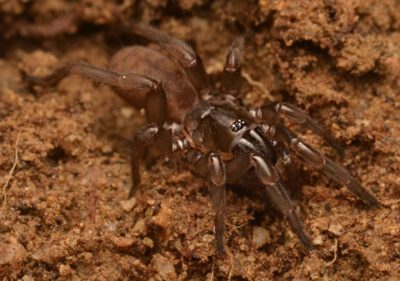
An expedition team, led by the Global Center for Species Survival at the Indianapolis Zoo, has rediscovered a species of trapdoor spider that had been lost to science since it was first described by a pioneering female entomologist in 1931. Fagilde's trapdoor spider (Nemesia berlandi) is the 12th most wanted lost species to be rediscovered since Re:wild's Search for Lost Species launched in 2017.
“Fagilde's trapdoor spider is the only species endemic to mainland Portugal that hasn't had a documented sighting for nearly a century or longer,” said Sérgio Henriques, invertebrate conservation coordinator at the Global Center for Species Survival at the Indianapolis Zoo and the leader of the expedition that rediscovered the spider. “This is a remarkable species. Fagilde's trapdoor spider is as Portuguese as Fado and it is our duty to ensure it remains part of our natural heritage. Its continued existence is a testament to Fagilde and the Vale Carcia people who have protected their local forests.”
The expedition team searched forested areas around Fagilde and inside the village limits between August 2021 and November 2023, combing the leaf litter for trapdoor spider burrows and building artificial spider-hiding spots in hopes of enticing wandering male spiders. Because autumn is the typical breeding season for other trapdoor spider species, the team believed the season would also be the best time to find Fagilde's trapdoor spiders outside of their camouflaged burrows.
In 2011, Henriques had found horizontal burrows—an orientation that is unique to Fagilde's trapdoor spiders—in a forested area in Fagilde, but none had spiders living in them, only their remains. A decade later, in 2021, the expedition built on Henriques' earlier searches and returned to those same wooded areas in Fagilde and nearby sites.
The team's persistence and patience were rewarded on one of their many expeditions. They found a silk-covered burrow—a tell-tale sign of trapdoor spiders. Trapdoor spiders dig their 4-inch-long (10-centimeter) burrows in the soil with circular doors that are at most an inch (2.5 centimeters) in diameter and may not leave their burrows for years except to find food or mates.
However, the burrow the team found was not built completely vertical to the ground (as most other species of trapdoor spiders build their burrows). Instead the burrow entrance extended horizontally beneath the soil before dropping vertically deeper into the soil. The burrow also had a circular door that was locked from the inside. Henriques gently excavated the side of the burrow, and found an adult female inside guarding about 10 baby spiders.
The spider was found in the only area where Fagilde's trapdoor spider had ever been recorded, and had the same dorsal pattern as mentioned in the species' original 1931 description.
Despite that compelling evidence, the only way for the team to definitively determine if they had found Fagilde's trapdoor spider was through minimally invasive DNA analysis. Spiders can detach their legs as a defense, which they are able to regrow. The team used that natural behavior to collect one of the spider's legs and preserved it in ethanol. They then safely returned the spider to her burrow.
DNA analysis revealed that the spider found inside a burrow in 2021 was not a genetic match for any other known trapdoor spider in the area, which meant it had to be the lost Fagilde's trapdoor spider the team was searching for.
“This is the first rediscovery for the Search for Lost Species in Europe, and it's a good reminder of just how incredible and unique invertebrates—who make up 97% of animal species on the planet—are,” said Christina Biggs, lost species officer for Re:wild. “Everything about this species delightfully defies what we usually expect of trapdoor spiders and it makes me hopeful for other overlooked species.”
Much of the search was designed based on what scientists know about other trapdoor spider species in the area. This shy spider generally stays in its burrow, using spider senses and silk to determine if the vibrations of animals outside are potential predators or prey.
During the breeding season, when the males find the burrows of potential females, they will gently and rhythmically drum on the door. Henriques describes the drumming as similar to a song that spiders are especially attuned to. If the female is receptive she will open the door and the two will mate.
Fagilde's trapdoor spider was originally described by Amélia Bacelar and her husband Fernando Frade in north-central Portugal. They described females of the species that were kept in a museum collection, but the specimens are believed to have been lost in a fire in 1978. Only the pair's original written description remains, a short note describing the animal's dorsal pattern (the pattern on its back), size and other traits. There are no other records of the species' behavior, ecology or even an analysis of its unique physical characteristics.
Although the question of whether the Fagilde's trapdoor spider still survives in the wild has been answered, Henriques is concerned about the species' future. Fagilde and the surrounding area have experienced increasingly intense and frequent wildfires during the past decade and an expanded reservoir will flood habitat where the spider lives.
Henriques has been working with the local community in Fagilde to teach them about the species and engage them in search efforts, and community members have become increasingly enthusiastic. Locals report any unusual spider sightings to him. The extra eyes in the community and renewed interest in trapdoor spiders have even yielded the discovery of a new-to-science species of spider in a nearby region.
Since the Search for Lost Species launched in 2017, working with partners across the globe, Re:wild has confirmed the rediscovery of these 11 additional species on the list of the world's most wanted lost species: Jackson's climbing salamander in Guatemala, both the Wallace's giant bee and the velvet pitcher plant in Indonesia, the silver-backed chevrotain in Vietnam, the Somali sengi in Djibouti, the Voeltzkow's chameleon in Madagascar, the Fernandina giant tortoise in the Galápagos, the Sierra Leone crab in Sierra Leone, the Pernambuco holly tree in Brazil, Attenborough's long-beaked echidna in Indonesia and De Winton's golden mole in South Africa.
Re:wild
www.rewild.org






